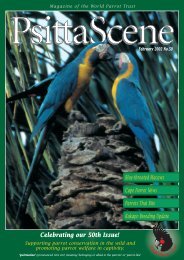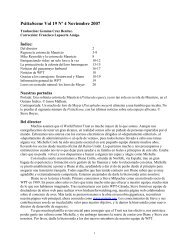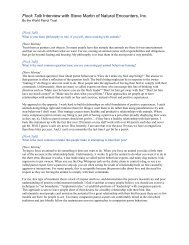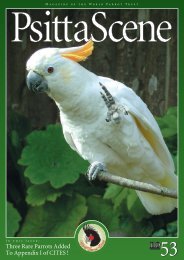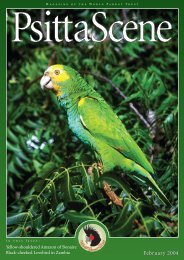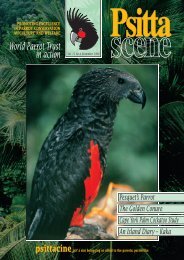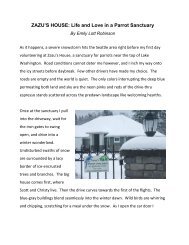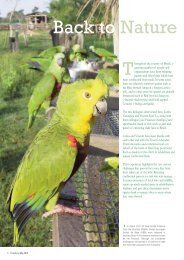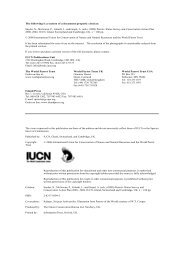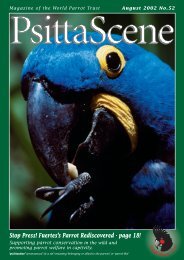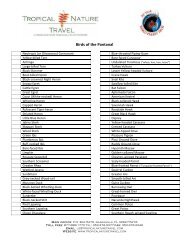PS 20 1 Feb 08.qxd - World Parrot Trust
PS 20 1 Feb 08.qxd - World Parrot Trust
PS 20 1 Feb 08.qxd - World Parrot Trust
Create successful ePaper yourself
Turn your PDF publications into a flip-book with our unique Google optimized e-Paper software.
I N T H I S I S S U E<br />
700+ Greys Set Free<br />
Feather Picking Frustration<br />
<strong>Feb</strong>ruary <strong>20</strong>08
Volume <strong>20</strong> Number 1<br />
Psitta<br />
Scene<br />
<strong>World</strong> <strong>Parrot</strong> <strong>Trust</strong><br />
Glanmor House, Hayle, Cornwall,<br />
TR27 4HB, UK<br />
contents<br />
2 From the Director<br />
3 A 2nd Chance for<br />
Confiscated Greys<br />
6 On Life in Africa -<br />
The Meyer’s <strong>Parrot</strong> Project<br />
11 Cachañas - The Austral<br />
Conure of Patagonia<br />
14 Feather Picking Frustrations<br />
18 Creative Conservation<br />
19 WPT Contacts<br />
<strong>20</strong> <strong>Parrot</strong>s in the Wild:<br />
Austral Conure<br />
fromthedirector<br />
OOne of the most exciting things about the <strong>Trust</strong> - and by extension my job as director - is<br />
that we're constantly looking towards new horizons, tackling new challenges, and learning new<br />
things about the world of parrots.<br />
As we move beyond the EU trade campaign, we're now turning our attention to new fronts.<br />
We are immersed in a promising bird trade project in Cameroon (see page 3) and I spent the<br />
last part of <strong>20</strong>07 exploring bird markets in east Asia. It turns out that much of the Asian bird<br />
trade is generated by a curious and longstanding tradition - that of releasing birds in religious<br />
rituals. These practices now lead to the harvest and release of many millions of wild birds<br />
across Asia each year. Naturally, this also results in the deaths of millions more not to<br />
mention causing serious conservation and disease risks as well. Sorting out the relationships<br />
between these trade niches while creating viable solutions should challenge us and our<br />
partners for the foreseeable future.<br />
With each new development in the parrot world we find our conservation plate continues to<br />
overflow. Recently we found that a bird so familiar to us all - the Sun Conure - turns out to be<br />
among the rarest of all parrots in the wild. On the border of Guyana and Brazil, this stunning<br />
parrot is just the latest casualty of a "legal" trade that has reduced their numbers to possibly<br />
only hundreds in the wild. Hopefully there is still time to save the wild birds. Please stay tuned<br />
as we begin work on this effort in the coming year.<br />
<strong>20</strong>07 was an exceptional year for the <strong>Trust</strong>. I want to extend a special thank you to all of our<br />
members and supporters for making our work possible. <strong>20</strong>08 holds new and exciting promise<br />
for the parrots of the world, and I hope you too will enjoy learning all about it in the<br />
twentieth (!) volume of the PsittaScene.<br />
Editor: Joanna Eckles<br />
Production: Karen Whitley<br />
The <strong>World</strong> <strong>Parrot</strong> <strong>Trust</strong> does not<br />
necessarily endorse any views or<br />
statements made by contributors to<br />
PsittaScene.<br />
It will of course consider articles or<br />
letters from any contributors on their<br />
merits. Go to parrots.org/publications<br />
for Guidelines.<br />
Anyone wishing to reprint PsittaScene<br />
articles in full or in part needs permission<br />
from the author / photographer and must<br />
state that it was copied from PsittaScene.<br />
All contents © <strong>World</strong> <strong>Parrot</strong> <strong>Trust</strong><br />
Printed by Brewers of Helston Ltd<br />
www.brewersgroup.com<br />
Jamie Gilardi<br />
Director<br />
onourcovers<br />
FRONT In their last step before complete freedom, hundreds of confiscated grey parrots are<br />
released from cramped travel boxes into a “halfway house” aviary in Cameroon, west Africa.<br />
Although many were discovered to be in poor physical condition, over 700 were sufficiently fit<br />
for quick and successful release. © Limbe Wildlife Centre<br />
BACK The Austral Conure (Enicognathus ferrugineus), like many parrots, has barely been<br />
studied in the wild. Basic field research (see Cachañas page 11) supplies key information that<br />
can be used to track their status over time. © Tom Rogers<br />
2 PsittaScene <strong>Feb</strong>ruary <strong>20</strong>08
A 2nd Chance<br />
for confiscated greys<br />
One...<br />
TThe illegal trade in wildlife is a difficult problem<br />
in many areas of the world often involving large<br />
sums of money and corruption at many levels.<br />
Naturally, African Grey parrots in Cameroon and<br />
throughout equatorial Africa are a special focus<br />
of this trade, and we have worked actively there<br />
to fund guards at known trapping areas and have<br />
remained in touch with contacts throughout the<br />
region to keep abreast of developments. Recently<br />
we were tipped off about possible illegal exports<br />
of African Greys from Cameroon, but it was<br />
only with the help of local wildlife enforcement<br />
organisation the Last Great Ape Organization<br />
(LAGA) that the authorities acted. LAGA was<br />
able to get a government minister interested in<br />
publicising the smuggling attempt and to make an<br />
example of the two men responsible.<br />
Two...<br />
While celebrating the rare smuggling convictions,<br />
our attention turned immediately to the birds -<br />
over a thousand wild African Greys seized just as<br />
they were being smuggled out of the country. To<br />
aid in their recovery and release, we supplied<br />
emergency funding in the first days of the crisis<br />
and swiftly implemented an online appeal on our<br />
website to tell the story and raise funds for relief.<br />
As the situation progressed, we sent veterinary<br />
assistance and critical medical supplies to help<br />
these birds - the victims of illegal trade in a<br />
favourite species of parrot lovers the world over.<br />
Photos: © courtesy of Limbe Wildlife Centre<br />
Free!<br />
After being illegally trapped and nearly<br />
exported from Cameroon on forged<br />
paperwork, over 700 of 1,2<strong>20</strong> African Grey<br />
<strong>Parrot</strong>s were released and given a 2nd<br />
chance at freedom.<br />
<strong>Feb</strong>ruary <strong>20</strong>08 PsittaScene 3
Their Story...<br />
...comes from Limbe Wildlife<br />
Centre in Cameroon where<br />
this recent unplanned<br />
diversion into parrots pulled<br />
attention from their usual<br />
charges - endangered<br />
L to R: Crates filled with illegally caught African Grey <strong>Parrot</strong>s are seized on the tarmac in<br />
released; visiting Italian veterinarians assist Limbe Wildlife Centre staff to pluck damaged<br />
primates seized from the<br />
bush-meat and pet trades.<br />
From Dr. Felix Lankester, Project Manager, Limbe Wildlife Centre<br />
On 24th November we received a call that<br />
approximately 500 African Grey parrots had been<br />
seized by the Ministry of Forests and Wildlife in<br />
Douala International Airport. The parrots were<br />
being illegally shipped to Bahrain to enter the<br />
exotic pet trade. We were asked to take the<br />
parrots as there was nowhere else for them to go.<br />
We do receive African Greys from time to time<br />
but usually in pairs, never in groups of 500<br />
birds! It was pandemonium when they all<br />
arrived, squashed into tiny crates, the live birds<br />
standing on top of their dead cage mates. It was<br />
a terrible scene.<br />
However, this was nothing compared to what<br />
was just around the corner, for on the 5th of<br />
December we received another call - a 2nd illegal<br />
shipment of birds was seized at the same<br />
airport. A truck arrived the same day loaded<br />
with its sickening cargo of dying parrots. The<br />
second shipment contained 727 birds - in less<br />
than 2 weeks we had received 1,2<strong>20</strong> birds.<br />
Coping with these unusual circumstances so<br />
quickly is a testament to our staff, who went<br />
from keeping apes to keeping birds overnight.<br />
on the branches of fruiting trees) or being too<br />
sick for release. These birds began a long-term<br />
course of rehabilitation and treatment.<br />
This is a tragic story of wildlife being exploited<br />
for the international trade in exotic pets, one of<br />
the most lucrative illegal trades in the world.<br />
However, due to some diligent work by those<br />
responsible for implementing the wildlife laws of<br />
Cameroon, at least these birds have been saved.<br />
Their case has drawn international media<br />
attention and uncovered corruption at a very<br />
high level. The focus on the parrot trade allowed<br />
LAGA to uncover how white-collar criminals<br />
thrive on complicity to gain a legitimate cover<br />
and eliminate the risk factor, and, perhaps most<br />
importantly, it has persuaded the national<br />
government to take action against those in charge.<br />
How many other shipments of birds make their<br />
way out of the country undetected we can only<br />
dread to imagine. The story of these parrots,<br />
and that of so many other animals, signal how<br />
the forests of Cameroon are being plundered by<br />
the unsustainable trade in wild animals. This can<br />
not continue.<br />
We had to move quickly to accommodate the<br />
birds and begin building new flight cages. Right<br />
away, 681 parrots were released in nearby<br />
forested sites. Another 59 were selected for<br />
release six weeks later. They, like most of the<br />
remaining birds, had put on considerable weight<br />
by then and were looking much stronger and<br />
healthier. Still, the remaining 300 or so birds<br />
were unreleasable at that time, having damaged<br />
or glued feathers (they were trapped using glue<br />
I would like to thank all those who have rallied<br />
behind us at Limbe Wildlife Centre in our hour<br />
of need to provide emergency funding,<br />
equipment and assistance: they are the <strong>World</strong><br />
<strong>Parrot</strong> <strong>Trust</strong>, the Born Free Foundation, the<br />
Born Free Foundation - USA, the Humane Society,<br />
and all the individuals who have donated funds.<br />
4 PsittaScene <strong>Feb</strong>ruary <strong>20</strong>08
Cameroon; terrible conditions in crowded boxes; flight cages built to house hundreds of birds that could not be immediately<br />
feathers in order to speed recovery before release.<br />
From Dr. Gino Conzo, DVM, Napoli, Italy<br />
At the beginning of December the <strong>World</strong> <strong>Parrot</strong><br />
<strong>Trust</strong> informed me about a very large seizure of<br />
African Grey parrots and put me in touch with<br />
Dr. Felix Lankester at Limbe Wildlife Centre to<br />
provide emergency advice.<br />
As the weeks went by and all the releasable birds<br />
were freed, it became clear that the remaining<br />
birds needed their damaged feathers removed.<br />
This long and tedious procedure was urgently<br />
required to speed the growth of new feathers<br />
and allow the birds to be released much more<br />
quickly. When the <strong>Trust</strong> asked me if I would be<br />
willing to travel to Limbe to assist, I gladly<br />
accepted. On January 16, I travelled to<br />
Cameroon with Mario D'Angelo, an Italian<br />
volunteer. Our bags were packed with<br />
antibiotics, latex gloves, syringes, suture thread,<br />
and a large supply of vitamin supplements<br />
donated by Gea International. A supply of hard<br />
to obtain injectable Doxycycline had been<br />
procured by the <strong>Trust</strong> in Switzerland and<br />
shipped by DHL to Limbe.<br />
We understood right away, as the hot and humid<br />
weather greeted us at our arrival in Douala, that<br />
our task would not be simple. This is the dry<br />
season in Cameroon, with temperatures<br />
averaging 85°F (30°C) with high humidity. Still,<br />
despite the discomfort, our first morning<br />
showed us a rich and seemingly intact nature.<br />
We received a warm welcome from Felix and all<br />
the staff at the LWC, and started to work<br />
immediately in an area that had been set up for<br />
us close to the two aviaries where the parrots<br />
are kept.<br />
It turned out that most of the flight feathers<br />
of all the birds were either cut or broken, or<br />
covered with the glue used to trap them, but<br />
the birds were otherwise in good nutritional<br />
condition. One by one we caught and<br />
anaesthetized each parrot with Isofluorane,<br />
removed damaged feathers with surgical<br />
tweezers, and medicated the follicles to prevent<br />
infection. This was how we preceded, bird after<br />
bird, all day for over five days. I was very<br />
grateful for Mario's help as the heat, the<br />
humidity and the insects didn't allow me to<br />
proceed as quickly as I would have liked to. At<br />
some point we started taking turns plucking the<br />
birds, so that we could each rest for a while or<br />
take care of something else.<br />
As each bird was anaesthetized, it received a<br />
general health check. About twelve birds had<br />
open wounds on their chests that appeared to<br />
be old and caused by hard falls. They were<br />
medicated and placed in smaller cages. Some will<br />
probably need surgery to reduce the size of the<br />
wound and speed their recovery. Four birds had<br />
string tied to a leg or a ring, as they were likely<br />
used as trapping lures.<br />
Our work day started at 8 am and continued<br />
with no breaks until 5 pm. We made sure to<br />
leave the birds alone when there were still a<br />
couple of hours of daylight before sunset, so<br />
that they could eat, as they wouldn't touch any<br />
food in our presence. Their diet consists of<br />
fruits, African palm nuts, and a mash made with<br />
corn and cassava flour, to which we advised the<br />
addition of cooked beans. The mash is<br />
medicated with 1% Doxycycline - to treat the<br />
Chlamydiosis that was previously diagnosed and<br />
to prevent infection in the feather follicles - and<br />
Phytotherapic supplements containing vitamins,<br />
amino acids, and minerals to help stimulate the<br />
growth of the new feathers.<br />
We were also able to provide other advice to<br />
give these parrots the best chance of successful<br />
recovery and eventual release. We advised<br />
modifications to the aviaries such as soft<br />
bedding like straw or other materials to reduce<br />
the traumatic effects of falls since many of the<br />
parrots are unable to fly. We also suggested they<br />
substitute the metal food and water containers<br />
with others made with safer materials, to lower<br />
the height of the perches, and to shield the<br />
aviaries with palm leaves or other materials to<br />
create a visual barrier between the birds and the<br />
visitors and reduce their stress.<br />
The Limbe staff were also trained on the best<br />
ways to handle the parrots, on how to medicate<br />
them and on how to perform small medical<br />
procedures.<br />
All in all it was a great experience, not easy but<br />
very rewarding. We were able to treat all of the<br />
birds and we are looking forward to the day<br />
when they will be set free.<br />
TTo learn more or to contribute to this<br />
effort email uk@worldparrottrust.org<br />
or visit www.parrots.org and click<br />
this link:<br />
<strong>Feb</strong>ruary <strong>20</strong>08 PsittaScene 5
On Life in Africa :<br />
interview with a parrot researcher<br />
Steve Boyes, a wilderness guide and PhD<br />
Zoology student at the University of<br />
KwaZulu-Natal, South Africa, answers some<br />
questions about his experiences studying the<br />
Meyer's <strong>Parrot</strong>. Steve is currently working<br />
with the <strong>World</strong> <strong>Parrot</strong> <strong>Trust</strong> on a lobby to get<br />
the wild-caught bird trade banned in South<br />
Africa and writing up his PhD Zoology in<br />
Pietermaritzburg, South Africa. These are<br />
some insights from running the Meyer's<br />
<strong>Parrot</strong> Project in the Okavango Delta…<br />
How did you first get involved<br />
in African <strong>Parrot</strong> Research?<br />
Since childhood I have been interested in<br />
African birdlife and my parents made sure that<br />
whenever possible we were in the wilderness<br />
areas of South Africa and Namibia learning<br />
and absorbing as much as possible. As a young<br />
birding enthusiast one of the easiest calls to<br />
identify is the contact call of a Poicephalus<br />
parrot, for me the Meyer's and Brown-headed<br />
<strong>Parrot</strong>s (P. cryptoxanthus) in the Kruger<br />
National Park, South Africa. I remember<br />
reacting to this high-pitched contact call every<br />
time I heard it, repeatedly notifying those<br />
around me that a parrot had flown over - a<br />
habit I found very useful <strong>20</strong> years later. So, the<br />
inclination to study the Meyer's <strong>Parrot</strong> was<br />
always there. I had been living in the<br />
Okavango Delta for 18 months already,<br />
working for Wilderness Safaris as a camp<br />
manager and guide, when Professor Perrin at<br />
the University of KwaZulu-Natal, having<br />
learnt that I was hiding in the Okavango,<br />
approached me with the offer of a PhD<br />
Zoology on the Meyer's <strong>Parrot</strong>. Obviously, I<br />
jumped at the opportunity and my<br />
involvement in African parrot conservation<br />
and research has grown ever since.<br />
Photo: © Caitlin Lepper<br />
A group of Meyer’s <strong>Parrot</strong>s socialising in<br />
the morning before going off to feed.<br />
6 PsittaScene <strong>Feb</strong>ruary <strong>20</strong>08
Insights<br />
and<br />
Photos<br />
by Steve Boyes<br />
Why are you and your team so excited<br />
about working with the Meyer’s <strong>Parrot</strong>?<br />
Meyer's <strong>Parrot</strong>s (Poicephalus meyeri) have the<br />
widest distributional range of any of the<br />
African parrots, extending the length of Africa<br />
from South Africa all the way up to the<br />
southern Sudan. It is by far and away the most<br />
abundant parrot in Africa, best suited to the<br />
current climatic conditions and the<br />
predominance of savanna bushveld in southern<br />
and eastern Africa. Basically, given the current<br />
habitat conditions in Africa the Meyer's <strong>Parrot</strong><br />
is a niche specialist that got it right! This is<br />
the most important parrot in Africa and<br />
understanding the ecological mechanisms that<br />
support its success across the continent is<br />
fundamental to the development of a<br />
conservation plan for all African parrots. The<br />
Meyer's <strong>Parrot</strong> could provide insight into the<br />
limited distribution and questionable status of<br />
other Poicephalus parrots, such as the Cape<br />
<strong>Parrot</strong> (P. robustus), Niam-Niam <strong>Parrot</strong> (P.<br />
crassus), Yellow-faced <strong>Parrot</strong> (P. flavifrons),<br />
Ruppell's <strong>Parrot</strong> (P. ruppellii), and Jardine's<br />
<strong>Parrot</strong> (P. gulielmi). Due to their recent<br />
speciation, any research done on the Meyer’s<br />
can likely be used to develop conservation<br />
tools, such as nest boxes, for other Poicephalus<br />
parrots.<br />
Beyond all of this the Meyer's <strong>Parrot</strong> is a<br />
fascinating, intelligent and interactive bird that<br />
will always keep you guessing and amazed.<br />
Your first quiet experience in a tree as a female<br />
carefully considers you and then accepts that<br />
you probably pose no danger is truly spiritual.<br />
In those eyes and in that silence you realize<br />
that she is self aware and complex of<br />
character. She is truly weighing you up. After<br />
years on the project individually identifying the<br />
breeding pairs (using unique crown markings)<br />
we also began to see distinct characters in the<br />
individual parrots - brave, nervous, careless,<br />
aggressive, etc. The reality of getting to know<br />
any species intimately is truly exciting and<br />
stimulating.<br />
What other kinds of work<br />
are you involved in?<br />
I am currently working with the <strong>World</strong> <strong>Parrot</strong><br />
<strong>Trust</strong> to halt the import of wild-caught birds<br />
into South Africa, specifically the African<br />
Grey (Psittacus erithacus) and Senegal <strong>Parrot</strong><br />
(Poicephalus senegalus). We are in the process of<br />
networking with conservation NGO's,<br />
breeders and importers in order to avoid<br />
unnecessary backlash after we make our pitch<br />
to the government. For more information on<br />
this effort please contact me on<br />
boyes@worldparrottrust.org<br />
Otherwise, I am in the process of<br />
inaugurating the Okavango Cavity Nesting<br />
Project with the Botswana Department of<br />
Wildlife & National Parks and University of<br />
Botswana, looking at the breeding biology of<br />
all cavity nesting bird, mammal and reptile<br />
species in the Okavango Delta.<br />
A pair of Meyer's <strong>Parrot</strong>s launches into the<br />
morning sky from a favoured nest tree.<br />
Tell us one really memorable story<br />
from your years with the project?<br />
There is one particularly heart-breaking story.<br />
The pair (above) was the love story of the<br />
research project, as I had been tracking their<br />
breeding activity for three seasons. In <strong>20</strong>04, I<br />
individually-identified these parrots using their<br />
distinctive yellow crown markings. That first<br />
season they fledged two chicks, probably losing<br />
one due to the poor rains and resultant lack of<br />
suitable insect protein for rapid chick growth that<br />
year. In <strong>20</strong>05, they nested again, but this time<br />
due to an unknown predation event they lost<br />
their chicks after hatching. In <strong>20</strong>06, I missed<br />
them as I was working on the project from the<br />
University of California, Berkeley. When I<br />
arrived in <strong>20</strong>07 I was very interested to see<br />
whether they were still together and using the<br />
same nest cavity. They were, and thus became the<br />
<strong>Feb</strong>ruary <strong>20</strong>08 PsittaScene 7
stars of the <strong>20</strong>07 field season. We were<br />
expecting hatching to take place, so were<br />
visiting most of our nest cavities daily. One<br />
morning, I got a call from one of the<br />
volunteers, telling me that something was<br />
terribly wrong at this nest cavity. The male was<br />
screaming wildly at the entrance of the nest<br />
hole, but not going in. He was then joined by<br />
two other parrots, who added to the chaos.<br />
They were so excited that at times they seemed<br />
to be fighting with each other. Then after two<br />
hours of observation a genet (right) stuck its<br />
head out the hole, thus confirming that the<br />
female and eggs had been destroyed. Upon<br />
inspecting the nest a week later, we found that<br />
she had been killed along with one hatchling<br />
and two unhatched eggs. It was devastating to<br />
watch the male calling and calling in the tree.<br />
He stayed there for three days, calling late into<br />
the night. We even saw him flying around in<br />
the moonlight in distress. This parrot was truly<br />
self aware and did love his partner - this was<br />
more than pair-bonding, they were a<br />
partnership for life.<br />
What are some of the recent<br />
accomplishments in the<br />
Meyer's <strong>Parrot</strong> Project?<br />
In January <strong>20</strong>07 we set up our first<br />
independent research camp. The camp allows<br />
us to accommodate volunteers and dedicate<br />
every waking moment to parrot research and<br />
conservation through awareness programs,<br />
lectures to tourists, and the involvement of<br />
professional guides in the Okavango Delta. The<br />
<strong>20</strong>07 field season was made possible by funding<br />
from the British Ecological Society and several<br />
private donors, most notably Julie Drier, in the<br />
United States. On 5th <strong>Feb</strong>ruary the camp was<br />
christened "Vundumtiki <strong>Parrot</strong> Camp".<br />
"Vundumtiki" means "one small fish" - a<br />
phrase taken from a Bayei folklore story of the<br />
island. Vundumtiki Island is located on the<br />
junction of the Maunachira and Kiankiandavu<br />
Channels in the north-eastern Okavango Delta,<br />
Botswana. This is one of the remotest locations<br />
in the Okavango Delta system. It is 3 hours<br />
from the closest airstrip and 15 to 48 hours<br />
away from Maun, the closest town (300 km or<br />
185 miles away) - a true wilderness area. For<br />
our intensive research program during the<br />
primary parrot breeding season between<br />
January and July <strong>20</strong>07 we had two to four<br />
volunteers in camp at any one time. All had<br />
diverse and life-changing experiences.<br />
"Vundumtiki <strong>Parrot</strong> Camp" is the<br />
homebase for the Meyer's <strong>Parrot</strong><br />
Project. Vundumtiki Island is near<br />
the Maunachira Channel (right) in<br />
the Okavango Delta system (below).<br />
8 PsittaScene <strong>Feb</strong>ruary <strong>20</strong>08
What do volunteers to the project do?<br />
Basically a volunteer becomes part of the team<br />
and is involved in all aspects of the project and<br />
camp life (including washing, collecting fire<br />
wood, cooking, etc.). For the <strong>20</strong>07 field season<br />
our focus was the primary nesting season.<br />
Volunteers did 5 hour shifts monitoring active<br />
nest cavities, walking transects in the bush with a<br />
guide certified to walk in the "Big-5" area with<br />
guests, and preparing and cleaning research<br />
equipment. Volunteers joined the project for at<br />
least a month, and all expenses in camp were<br />
covered. All the volunteer needed to do was get<br />
to Maun and we would fly them out. The<br />
volunteers were mostly young students interested<br />
in ecology, coming from as far afield as the<br />
University of Arizona, USA.<br />
Life in the Okavango Wilderness is<br />
unpredictable and consequences when<br />
something goes wrong are absolute. We have to<br />
be extremely cautious in the way we do things.<br />
Nevertheless, most volunteers had diverse and<br />
life-changing experiences while working on the<br />
project. Among their stories were being charged<br />
by elephants, having lions kill a buffalo at a 10-<br />
hour nest observation site, sharing a shower with<br />
the local leopard, and warding off invasion by<br />
troops of baboons on the island. Thankfully, no<br />
one got hurt, only the local hyena when some<br />
shelves collapsed on him (actually I think the<br />
shelves were worse off than him).<br />
Thank you to all of you that worked so hard in<br />
setting up the camp, so patiently in the 10-hour<br />
observations, and so bravely on the bush walks,<br />
all in the name of parrot research and<br />
conservation. For me their involvement in the<br />
project was two-fold, whereby I wanted them to<br />
learn and form a personal relationship with the<br />
parrots while also appreciating the sense of place<br />
in a wilderness area away from all outside<br />
influence.<br />
In this part of Africa the safest place to stare<br />
through the spotting scope doing nest observation is<br />
from the roof of the LandRover.<br />
Project volunteers have exciting and unpredictable<br />
experiences while immersed in the project and the<br />
surroundings. This very relaxed leopard lounging<br />
on the deck outside the shower definitely spices up<br />
the bathing experience.<br />
What were your major results?<br />
Based on observations made between <strong>20</strong>04<br />
and <strong>20</strong>07 it became clear that avoiding interspecific<br />
competition by choosing specific<br />
seasonal food item and breeding strategies<br />
was central to answering a fundamental<br />
question put forward at the onset of the<br />
project: What factors enable P. meyeri to be<br />
so "successful" in its natural habitat? During<br />
the first two years of the Meyer's <strong>Parrot</strong><br />
Project we focussed on their feeding ecology,<br />
habitat preferences and general behaviour<br />
(e.g. breeding seasons, preening, allopreening,<br />
roosting, etc.) for correlation with<br />
rainfall seasonality, resource abundance, and<br />
the annual flood regime in the study area. In<br />
<strong>20</strong>06, I did data analysis at the University of<br />
California, Berkeley, in Prof. Steve<br />
Beissinger's Lab, raised funds and did project<br />
design for the <strong>20</strong>07 field season. The time in<br />
Berkeley revolutionised the way I look at<br />
ecological research and made my return to<br />
Vundumtiki a necessity.<br />
Major findings of the three years in the field<br />
include:<br />
· Meyer's parrots track resources based on<br />
abundance and avoiding competition with<br />
other frugivorous birds and primates. They<br />
vocalize when they find suitable food trees<br />
and target seeds from unripe fruits and<br />
leguminous posts that are inaccessible to<br />
other seed predators;<br />
· They can open the extremely hard nut cases<br />
of the Marula (Scherolcarya birrea), Real Fan<br />
Palm (Hyphaene petersiana), and Baobab<br />
(Adansonia digitata) fruits, thus gaining<br />
exclusive access to the protein rich seeds.<br />
This behaviour has not been observed in<br />
other birds in the Okavango Delta or<br />
Poicephalus parrots elsewhere in Africa;<br />
· Breeding was observed throughout the year,<br />
however, 95% of the breeding activity fell<br />
within the period March - July (i.e. the winter<br />
months). This seemed to be synchronous<br />
with the end of the wet season, the onset of<br />
the flood, the cessation of breeding activity<br />
in the Burchell's Starling (Lamprotornis<br />
australis) (thus avoiding competition with this<br />
large, aggressive cavity nesting bird species)<br />
and a peak in the infestation levels of<br />
parasitic larvae in the Marula fruit (Sclerocarya<br />
birrea), Terminalia sericea pods, Bushwillow<br />
pods (Combretum hereronse) and Mopane pods<br />
(Colophospermum mopane) - a food source they<br />
eat almost exclusively<br />
Please contact me on boyes@africaskyblue.org<br />
in order to obtain information on future peerreviewed<br />
publications coming out later this year.<br />
<strong>Feb</strong>ruary <strong>20</strong>08 PsittaScene 9
What are your hopes for the<br />
future of the project?<br />
Currently I am busy with my PhD Zoology<br />
write-up here at the University of KwaZulu-<br />
Natal, South Africa, after which I would like to<br />
return to the Okavango Delta to continue my<br />
work on the Meyer's <strong>Parrot</strong> with the Research<br />
Centre for African <strong>Parrot</strong> Conservation till the<br />
end of the year. We have three-year research<br />
and residence permits from the Office of the<br />
President in Botswana and concession from<br />
Wilderness Safaris Botswana for the same<br />
period to use Vundumtiki Island. We had<br />
limited success in the 105 nest boxes we put<br />
up around the study site in <strong>20</strong>07. We used 6<br />
different nest box designs, but did not achieve<br />
successful breeding in the nest boxes. We hope<br />
to test variations on the most successful design<br />
from the <strong>20</strong>07 breeding season in order to<br />
develop a nest box design that can be used in<br />
other areas where, due to clear-felling, suitable<br />
nest cavities do not exist.<br />
As is the case with any project of this nature,<br />
questions are self-sustaining as discoveries<br />
either undermine current assumptions or open<br />
up new possibilities for investigation. I am<br />
currently training Zenzele Mpofu from the<br />
Department of Wildlife & National Parks to<br />
take over the project from me when I am<br />
finished at the end of the year, so that we<br />
establish a long-term research station and<br />
possibly expand our scope to include other<br />
bird species. I would like to apply what I have<br />
learnt studying the Meyer's <strong>Parrot</strong> to other<br />
African parrot species, thus testing the<br />
While there was interest, we haven’t had<br />
breeding success in the nest boxes yet. We hope<br />
the boxes will be used in coming seasons,<br />
resulting in easier access to growing nestlings.<br />
assumptions about them resulting from this<br />
study. It is also my dream and focus to be able<br />
to, by <strong>20</strong>10, motivate a nine month "African<br />
<strong>Parrot</strong> Expedition" visiting all identified source<br />
areas for all African parrot metapopulations, and<br />
spending time assessing their breeding<br />
behaviour, status and conservation biology<br />
(especially any instances of human-parrot<br />
conflict and trade), while photographing, ringing<br />
and taking blood from all species and subspecies<br />
in order to once and for all complete the story<br />
of African parrot evolution and biogeography. I<br />
would appreciate any correspondence in regard<br />
to possible collaboration or support for this<br />
initiative.<br />
As is always the case we are dependent on<br />
research funding from funding agencies and<br />
charitable donations from private donors. To this<br />
end I would like to invite charitable donations to<br />
the project through the <strong>World</strong> <strong>Parrot</strong> <strong>Trust</strong>. Feel<br />
free to contact me for more information…<br />
Do you have any last words for readers?<br />
Antoine de Saint Exupery said: "Many have<br />
forgotten this truth, but you must not forget it.<br />
You remain responsible, forever, for what you<br />
have tamed." Let's stop the wild-caught bird<br />
trade, as we already have more than we can be<br />
responsible for, as can be seen in the emergence<br />
of organizations such as the Gabriel Foundation<br />
in Denver dedicated to taking care of<br />
abandoned companion parrots. Modern<br />
aviculture is now developed enough to supply<br />
the needs of international bird trade, thus<br />
supplying the basic human curiosity in all things<br />
beautiful and natural, our desire for<br />
unconditional companionship, and the peace we<br />
feel in the presence of an animal. A complete<br />
ban in the wild-caught bird trade is not only an<br />
economic and conservation requirement,<br />
but also an ethical necessity.<br />
Bushwillow grubs are the Meyer’s most<br />
significant dietary component during the breeding<br />
season. The high protein diet stops two weeks before<br />
fledging, after which the chicks are vegetarian.<br />
10 PsittaScene <strong>Feb</strong>ruary <strong>20</strong>08
Photo: © Ferran Juarez Pluvins<br />
Cachañas<br />
The Austral Conure of Patagonia<br />
By Soledad Díaz & Valeria Ojeda<br />
WWe wake early to the smell of wet ground. Vegetation surrounds us at<br />
our mountain base camp. Our breath shows in the light of our<br />
headlamps - made visible by the cold morning air as we prepare our<br />
equipment for the day. We split up - one person hiking to a distant<br />
Austral Parakeet nest to monitor parental behaviour all day - others<br />
visiting the remaining nests to measure adults and chicks.<br />
Hours after our 4am wake-up call, the magical atmosphere changes as<br />
the sun starts to appear through the canopy. It is a new day in<br />
Patagonia. Between the branches, birds start to wake up. It is a good<br />
day to watch parakeets! Not all days are so cooperative. Cold,<br />
humidity, late snows and wind can slow or stop our fieldwork for a few<br />
hours or days. A sunny day can turn cold in a few hours.<br />
At night, we reunite near the shelter fire, happy but exhausted, talking<br />
about details and anecdotes of the day. Night falls and the moon shows<br />
itself through the trees. We hear the first night birds - a new journey<br />
starts for them. New adventures await when we emerge from our<br />
sleeping bags again.<br />
<strong>Feb</strong>ruary <strong>20</strong>08 PsittaScene 11
LEFT Austral Conures are known for being<br />
very noisy in flocks. Local people used to<br />
say “When Cachañas fly down from the<br />
forest to town, a storm is coming.” In<br />
reality this is true. When a snow storm<br />
starts on the high Andes, parrots and<br />
other birds seek refuge in town.<br />
LOWER LEFT Conures create a soft nest<br />
with little pieces of wood extracted from<br />
the nest walls. Clutch size is 6-9 eggs,<br />
depending on the nest and the year but<br />
one nest was documented with 11 eggs!<br />
LOWER RIGHT Once chicks fledge they<br />
spend a lot of time socializing and playing<br />
in the branches and on the ground.<br />
Photo: © Ferran Juarez Pluvins<br />
Starting in 1998, we began a series of studies on<br />
the foraging ecology and reproductive biology of<br />
Austral Conures or Parakeets (Enicognathus<br />
ferrugineus) along with Dr. Ana Trejo from our<br />
university. Though it is a common bird in<br />
Patagonian forests, very little is known about this<br />
species. This lack of information is a big<br />
concern because we can´t measure the effects of<br />
deforestation and trade without basic knowledge<br />
of the species. Most of the references to Austral<br />
Conures in the literature consist of anecdotal<br />
Photo: © Valeria Ojeda<br />
reports on circumstantial encounters or<br />
observations made over short periods.<br />
Very little information had been published<br />
on foraging or breeding biology by the<br />
time we had begun our research.<br />
A mid-size parakeet (28-36 cm, 11-14 in),<br />
the Austral Conure is the most southerly<br />
distributed psittacids in the world. They are<br />
called Cachañas in the native language and<br />
are typical of the Andean Patagonian<br />
forests of southern Argentina and Chile,<br />
from sea level to <strong>20</strong>00 meters. They inhabit<br />
many different forest types, from Araucaria<br />
(Araucaria araucana) in its northern reaches<br />
to Southern Beech (Nothofagus spp.)<br />
extending to the southernmost tip of<br />
South America.<br />
Outside the breeding season (April-<br />
November) this species is highly<br />
gregarious. Large flocks explore food<br />
sources both inside and outside forests and<br />
in adjacent semi-open areas including<br />
ranchland and, at times, cultivations and<br />
urbanized sites. As breeding season<br />
approaches, flocks start to diminish in size,<br />
and from December to March, the conures<br />
remain in forested habitats, in pairs or<br />
small flocks.<br />
Nesting individually in tree cavities the<br />
Austral Conure has one brood per season.<br />
In the study area, nest initiation is typically<br />
very synchronized among pairs, possibly as<br />
a result of an even exploitation of the local<br />
food resources. Cavity enlargement or<br />
preparation starts in October and egg-laying<br />
takes place in December. Tree cavities for<br />
nesting and roosting can be natural (produced<br />
by rot) or excavated by the Magellanic<br />
Woodpecker (Campephilus magellanicus). Most of<br />
the nests we recorded were in live trees that<br />
contained noticeable heart rot that allowed<br />
enlargement of the cavities by the conures.<br />
Nesting cavities were normally reused in<br />
consecutive years, and we are suspicious that<br />
communal roosting holes are used during the<br />
winter, but this needs confirmation.<br />
Photo: © Tom Rogers<br />
12 PsittaScene <strong>Feb</strong>ruary <strong>20</strong>08
RIGHT Chicks are weighed and<br />
measurements are taken of the tarsus,<br />
wing, and head regularly until fledging.<br />
Feather development is also carefully<br />
tracked. These data helps researchers<br />
understand how the wild chicks develop.<br />
LOWER LEFT Newly hatched nestlings are<br />
very small and featherless. When trying to<br />
take measurements its hard to get over<br />
how delicate they seem!<br />
LOWER RIGHT Fieldwork can be fun and<br />
interesting but it is not glamorous. While<br />
monitoring parental behaviour and<br />
breeding biology, researchers spend long<br />
hours recording all observations at a nest.<br />
Photo: © Soledad Díaz<br />
Conservation Issues<br />
The Austral Conure is currently included in<br />
Appendix II of CITES and is considered of low<br />
concern in Chile and Argentina, in both cases<br />
with a zero extraction value (trade not allowed).<br />
But due in part to the lack of studies on this<br />
species, its conservation status is uncertain. The<br />
notion that it is "abundant" because large noisy<br />
flocks are observed during austral winters<br />
around urbanized sites may be misleading, since<br />
the actual status of most populations is<br />
unknown.<br />
Until now, this species was only known to be<br />
affected by habitat loss (forest loss and<br />
fragmentation), while the live bird trade was<br />
considered of minor impact. However, over the<br />
course of our studies we found a growing<br />
interest in this species as a pet, both at a local<br />
and at a distribution-wide scale.<br />
Photo: © Laura Chazarreta<br />
Causes for concern<br />
Austral Conure are potentially vulnerable during<br />
the reproductive season. They require very large<br />
trees to accommodate nesting cavities and<br />
depend on food sources close to their nesting<br />
sites. This leads us to propose that Austral<br />
Conures are dependent on rather continuous<br />
mature native forests for breeding purposes. As<br />
with other regions of the world, forestry<br />
operations are rapidly expanding towards the<br />
southern temperate forests, with logging projects<br />
extending throughout Chile and Argentina at an<br />
increased rate.<br />
Moreover, this species is now being persecuted<br />
and hunted during winter, when large flocks<br />
gather around villages and urbanized sites. We<br />
have witnessed people (mostly children) hunting<br />
the conures with slings when they perch and<br />
forage in small groups of trees. As a result,<br />
many birds are injured or killed and others are<br />
caught and sold at a very low price (about US<br />
$3). Once we were aware of this problem, we<br />
contacted the authorities. Surprisingly, we found<br />
a total lack of enforcement. This may be an<br />
emerging problem that was not part of the<br />
agenda of the official wildlife management<br />
agencies in the past. Unfortunately, we found<br />
that owls and other wildlife faced the same<br />
problem in urban areas. In this respect, both<br />
supervision of human activities and education<br />
programs seem fundamental to stop this<br />
negative attitude against wildlife from spreading.<br />
We suggest it is time to initiate conservation<br />
programs directed at the Austral Conure before<br />
they become more popular in the live bird trade<br />
culture, which, along with habitat loss, may result<br />
in the species becoming endangered within the<br />
next 10 years.<br />
Soledad Díaz & Valeria Ojeda: Laboratorio<br />
Ecotono. Departamento de Ecologia.<br />
Universidad Nacional del Comahue, 8400.<br />
Bariloche. Argentina. jisdiaz@yahoo.com.ar<br />
Photo: © Valeria Ojeda<br />
<strong>Feb</strong>ruary <strong>20</strong>08 PsittaScene 13
P . E . T Pages<br />
PsittaScene's PET Pages help you<br />
provide the very best for your bird by<br />
focusing on <strong>Parrot</strong> behaviour,<br />
Enrichment and Training.<br />
Photo: © EB Cravens<br />
This issue’s contributor Jim McKendry has<br />
spent many years rehabilitating Gang-Gang<br />
Cockatoos that have feather chewed. This<br />
female was once completely flightless and<br />
is now fully feathered.<br />
Jim is one of our online experts and<br />
answered this question on “Ask an Expert”<br />
on our website. He works full-time teaching<br />
science at St. Teresa’s Catholic College in<br />
Queensland, Australia. He has worked<br />
professionally with birds as a presentations<br />
keeper at Currumbin Wildlife Sanctuary<br />
and provides parrot behaviour and<br />
enrichment consultation services via his<br />
website at www.pbec.com.au.<br />
For more expert answers to parrot<br />
questions visit www.parrots.org<br />
> Forums, Experts & Bloggers<br />
Feather Picking Frustrations<br />
Q<br />
We have two African Grey parrots. Peaches is three years old and Vincent is 11 months old. Both<br />
birds have their own cages and a quiet room to sleep in, away from the family. They have an average<br />
of 10-12 hours sleep each night. Their diet is a mixture of pellets, seed, fresh fruit, vegetables, the<br />
occasional treat and a supplement of palm nut oil. They are showered once a week and sprayed every<br />
other day. Both have free flight time when we are home and are out of their cages with the family for<br />
a minimum of 5 hours, but often eight hours or more.<br />
Peaches is healthy, happy and well adjusted. Unfortunately, Vincent started plucking his breast feathers<br />
when he was 8 months old. We visited the vet, who advised us it was not medical. We have checked all<br />
the common environmental and diet-related causes to no avail. His feathers are starting to grow back<br />
but occasionally he appears to pluck these out, usually when I go out! This tells me it's likely to be<br />
abandonment stress but how do I overcome this? I have tried to give him treats or toys before I go<br />
out, we leave a radio on for both birds who are both in the same room for company but in different<br />
cages.<br />
I have also noticed that Vincent appears to be rather possessive and often objects when I hold<br />
Peaches or when anyone come close to me. We have tried to discourage this by asking the family to<br />
interact with him more. He will go to them but often only for a few minutes before he flies to me. Is<br />
this an age thing as he is still a baby?<br />
Please help as we feel so responsible and want Vincent to be as happy and well adjusted as Peaches is.<br />
Jo<br />
A<br />
G'day Jo,<br />
Without a doubt, trying to manage feather<br />
picking behaviour is the most challenging of the<br />
behavioural issues we encounter in captive<br />
parrots. It is very difficult for me to cover all the<br />
bases in writing for an issue as potentially<br />
complex as feather picking. Not being able to<br />
actually see the environment or observe Peaches,<br />
will limit my response to generalisations.<br />
Nevertheless, I have extensive first hand<br />
experience with this particular issue as a<br />
consultant and I can certainly cover some food<br />
for thought from the insights you have shared.<br />
Hopefully that will help you develop some<br />
strategies to minimise the feather picking<br />
behaviour.<br />
Firstly, you've done the right thing by consulting<br />
a veterinarian first. My advice to clients<br />
managing any problems involving poor<br />
feathering or feather damage in their parrots is<br />
Photo: © Jim McKendry<br />
African Grey <strong>Parrot</strong>s are particularly prone to<br />
establishing feather picking behaviours in<br />
unenriched environments.<br />
14 PsittaScene <strong>Feb</strong>ruary <strong>20</strong>08
to seek veterinary advice first. All the<br />
behavioural intervention in the world won't help<br />
a parrot that is physically ill. As you have sought<br />
veterinary advice and have been advised that the<br />
problem is behavioural, let's focus on the key<br />
general areas that you can start considering.<br />
Diet & Foraging<br />
Scientific studies have demonstrated a significant<br />
disparity between wild and captive parrots in the<br />
time spent actively engaged in foraging and<br />
feeding behaviours. Reduced active foraging can<br />
be considered a precursor to "boredom" or lack<br />
of activity. This activity deficit has been linked to<br />
excessive amounts of time spent preening by<br />
captive parrots, which of course has been linked<br />
to improper care of feathers over time. The<br />
more dynamic, variable and creative you can be<br />
in presenting food, the longer the parrot will<br />
need to spend "foraging." This strategy has been<br />
used for decades in the zoo industry to reduce<br />
stereotypical behaviours in a range of animal<br />
species. The relevance for our companion<br />
parrots should be obvious.<br />
Diet management involves more than just<br />
withholding favoured foods for training treats.<br />
Creative diet management for parrots focuses on<br />
a range of goals. Initially, it is beneficial to<br />
establish a formulated diet as the daily base for<br />
food consumption. Then supplement this with a<br />
range of other food types, including fruit,<br />
vegetables, seeds, natural foliages and even live<br />
foods such as mealworms. The composition ratio<br />
of each of these supplements should be<br />
considered at a species-specific level. Not only<br />
will a diet based on a formulated food provide<br />
sound nutrition whilst minimising fat intake, it<br />
will also enhance the parrot's motivation to<br />
forage for more palatable items such as nuts and<br />
seeds.<br />
You have described a good diet for your African<br />
Greys. However, we often stop at ensuring all<br />
nutritional bases are covered, without taking the<br />
next step and considering the "when" and "how"<br />
of delivering the food. Ideally, time spent<br />
feeding (a behaviour that is incompatible with<br />
sitting around picking at feathers) is maximised.<br />
This may be particularly important at times<br />
when we are not around to provide the<br />
alternative stimuli needed to redirect feather<br />
picking behaviour.<br />
Diet management therefore extends to catering<br />
for food allocation at various times of the day.<br />
Most parrot species do not feed for only an<br />
hour in the morning and an hour in the<br />
afternoon as some articles claim. Feeding<br />
durations of up to 8 hours and at all times of<br />
the day have been observed in the wild.<br />
Therefore we may need to consider catering for<br />
the natural tendency to forage outside of an<br />
established captive feeding regime. From your<br />
description, you may have the ability to feed<br />
Peaches and Vincent around those times when<br />
you leave the house. By doing this you are<br />
introducing a stimulus that is likely to offer a<br />
highly motivating alternative to feather picking<br />
when you are absent.<br />
In my experience, creative food delivery still has<br />
limitations in the remediation of feather picking.<br />
Best results for providing alternatives to chewing<br />
on feathers are usually derived from the<br />
provision of natural foraging "browse". This<br />
requires a species-specific understanding of<br />
parrots and an appreciation of the huge<br />
variability in foraging behaviours and<br />
preferences. What works as a foraging motivator<br />
Photo: © Arlene Alpar<br />
Great ideas such as delivering food in foraging toys<br />
rather than open bowls can reduce boredom and<br />
feather picking behaviour.<br />
Photo: © Jim McKendry<br />
Providing natural foraging browse, such as the<br />
Allocasuarina cones eagerly taken by this Gang-<br />
Gang Cockatoo, offers the most effective redirection<br />
for feather chewing behaviour for many species.<br />
for one species, or even one individual, may not<br />
work for another. In any case, if the daily food<br />
intake is staggered it is important to provide<br />
natural foraging opportunities outside of those<br />
times. This can reduce boredom, stress and<br />
anxiety due to separation, and relieve pressures<br />
associated with behavioural feather picking.<br />
Many parrot owners simply don't have access to<br />
suitable, natural foraging items. In these cases,<br />
we need to reflect on the suitability of the<br />
artificial enrichment and toys being provided. A<br />
lot of the traditional parrot toys lack functional<br />
relevance for the birds they are provided for.<br />
Fortunately, more and more toys and products<br />
specifically designed as "foraging" items are now<br />
available. <strong>Parrot</strong>s engage with them with the<br />
goal of procuring hidden food treats. We can<br />
now provide these items as an alternative to<br />
natural browse. If your parrot lacks interest in<br />
the toys and artificial enrichment on offer, it's<br />
time for a change. The WPT Store is now<br />
stocking some cool toys for pet parrots that are<br />
worth a look!<br />
<strong>Feb</strong>ruary <strong>20</strong>08 PsittaScene 15
Home Sweet Home!<br />
An enclosure that facilitates "normal"<br />
behaviours needs to accompany a dynamic<br />
and creative approach to food management.<br />
In my experience, most pet parrots are<br />
maintained in enclosures far too small, and<br />
for too long, to maintain optimum<br />
behavioural health. Larger enclosures<br />
obviously facilitate the provision of a wider<br />
range of materials, substrates, perching and<br />
food positioning options. If small enclosures<br />
are used it may be beneficial to develop a<br />
regular routine of varying furnishings. Care<br />
should be taken with sensitive individuals with<br />
a history of aversive reactions to changes. For<br />
such individuals allow for gradual<br />
desensitisation to enrichment items, and even<br />
new perches in extreme cases.<br />
Bear in mind that parrot owners can "over<br />
provide" enrichment items and inadvertently<br />
create a cluttered environment that reduces<br />
healthy movement within the enclosure.<br />
Providing excessive amounts of artificial<br />
enrichment may also result in a lack of interest<br />
in such items. A rotation schedule, with a<br />
minimum number of artificial enrichment<br />
items being provided for no more than a week<br />
at a time, may be far more beneficial than a<br />
"saturation" approach. This is often<br />
particularly relevant for young parrots. When<br />
we consider enclosure suitability we also may<br />
need to consider the position of the enclosure.<br />
Incompatibility stress with other animals in the<br />
environment might be a potential contributor<br />
to feather problems. This possibility prompts<br />
the need for careful observation of any parrot<br />
that is housed with or around other birds and<br />
animals and is damaging its own feathers with<br />
appropriate modifications made if necessary.<br />
The ideal, in my opinion, is to provide<br />
companion parrots with access to an outdoor<br />
aviary. This facilitates enhanced provision of<br />
natural browse and exposes the bird to a huge<br />
variety of natural stimuli, particularly visual and<br />
aural stimuli, that is rarely achieved indoors.<br />
Whilst many of us may not be able to provide natural foraging browse, you can certainly create an artificial environment that offers plenty of stimulation!<br />
Photo: © Arlene Alpar<br />
16 PsittaScene <strong>Feb</strong>ruary <strong>20</strong>08
Bathing Schedules<br />
Skin and feather health may be dependent to<br />
varying degrees on humidity and access to<br />
bathing opportunities. Owners of companion<br />
parrots kept indoors, particularly in airconditioned<br />
environments, may need to reassess<br />
the bathing schedule of their bird if behavioural<br />
feather picking is diagnosed. I have consulted<br />
with a number of feather picking birds that were<br />
rarely, if ever, bathed or provided with<br />
opportunities to self-bathe. This is very<br />
important for keepers of neo-tropical species<br />
whose natural range is within areas of high<br />
annual rainfall. Proper access to bathing<br />
promotes natural preening behaviours and can<br />
often be a significant component of successful<br />
recovery. In the case of Peaches and Vincent,<br />
the bathing schedule you have described should<br />
be more than adequate.<br />
A Social Life<br />
It's great to see that we have an environment<br />
here with two African Greys and not just one.<br />
Companion parrots are often deprived of<br />
natural physical interactions with conspecifics<br />
(same species). When we consider that mutual<br />
preening is an integral part of natural pair bond<br />
behaviour for a range of species commonly kept<br />
as pets, the lack of access to such interactions<br />
can be considered contributory to some cases of<br />
excessive preening leading to feather damage.<br />
Aside from the physical aspect, balancing social<br />
interaction for pet parrots encompasses the<br />
behavioural and cognitive side as well. Most<br />
parrot species (the Kakapo is one exception) are<br />
highly social and often form strong pair bonds.<br />
It is extremely unnatural for most parrots to be<br />
alone for most of the day, as many pet parrots<br />
often are. I firmly believe that many parrots fail<br />
to cope with the inconsistencies of the humanparrot<br />
bond and as a result we often see<br />
behavioural abnormalities arise. Obviously there<br />
are exceptions, but there is little arguing that<br />
captive parrots that are kept alone and without<br />
regular human interactions will benefit from the<br />
stimulation of another parrot, preferably of the<br />
same species, in their environment. A whole<br />
suite of behaviours can be observed between<br />
parrots, even in different enclosures, housed in<br />
the same environment that would otherwise be<br />
absent in a solitary individual. Such stimulation<br />
can equate to increased activity and engagement<br />
in enrichment items and less time spent<br />
damaging feathers. The key to this strategy is<br />
achieving compatibility and minimising<br />
incompatibility stress.<br />
Jo, you have covered this consideration as well as<br />
any companion parrot owner can by having two<br />
African Greys in the environment. We're still<br />
short of the ideal for avoiding feather picking by<br />
not having a truly compatible partnership, but<br />
Vincent is still very young. Over time, hopefully<br />
the level and quality of interactions between<br />
Peaches and Vincent will improve and provide<br />
both of them with a stronger diversion from<br />
picking in your absence.<br />
Finally, considering your question about whether<br />
Vincent flying to you and not staying with other<br />
family members or visitors for long durations is<br />
"age related behaviour". Whilst a young parrot at<br />
11 months of age will certainly still tend to<br />
gravitate towards whomever it has a wellestablished<br />
parental association with, it's perhaps<br />
best to consider this behaviour purely from a<br />
reinforcement schedule perspective. It's likely<br />
that the behaviour of flying back to you is<br />
reinforced with more consistency, and better<br />
contiguity, than the reinforcement on offer from<br />
others wanting to handle him. It's also likely<br />
that the interactions Vincent has with you are<br />
more positively reinforcing in general and that<br />
he has established a stronger association with<br />
you as someone who is predictable, and offers<br />
rewards on a more consistent schedule than<br />
others. Try making your goals more<br />
achievable for Vincent by setting up a<br />
reinforcement schedule from other people<br />
that is more consistent and less variable than<br />
is perhaps presently being delivered.<br />
Jo, managing feather picking is an on-going<br />
process of reflection, careful evaluation of<br />
the functional interaction and relationship<br />
between the behaviour and the environment,<br />
and a dedicated approach to creating<br />
alternatives to feather chewing. If the<br />
problem persists then I would recommend<br />
seeking out some professional advice and<br />
support on-site from a consultant or<br />
veterinarian who may be able to work with<br />
you on some strategies specific to your<br />
environment.<br />
Kind Regards from `Down Under',<br />
Jim McKendry<br />
Photo: ©Jim McKendry<br />
Social compatibility is important in reducing the potential for feather picking. Only one of these Blue & Gold<br />
Macaws is a feather picker - Can you identify which one?<br />
<strong>Feb</strong>ruary <strong>20</strong>08 PsittaScene 17
Local art supports clay lick protection<br />
In partnership with Peru Verde, the <strong>World</strong> <strong>Parrot</strong> <strong>Trust</strong> is proud to introduce<br />
Arpilleras. These amazing one-of-a-kind fabric artworks support a community in one<br />
of the very wildest areas of the Peruvian Amazon. The community in turn protects<br />
their local clay licks – an arrangement that benefits parrots and humans alike.<br />
S<br />
Since 1995, Peru Verde, a Peruvian conservation<br />
group, has been developing ecotourism sites at<br />
existing macaw clay licks in the Peruvian<br />
rainforest. In Sepahua, a small Peruvian town on<br />
the Lower Urubamba River, the forest is quite<br />
intact, with several spectacular macaw clay licks<br />
used by over 1,000 parrots and over 300 macaws<br />
during the high season (August through<br />
October). After trying to introduce ecotourism<br />
to the area, Peru Verde found the area was too<br />
remote to be profitable. The mostly indigenous<br />
community who owns the area had agreed to<br />
protect their clay licks, but without tourism, they<br />
needed to find an alternative means of support.<br />
With few other employment options in the area,<br />
the community agreed that the best option for<br />
creating jobs related to conservation was<br />
through the art of Arpilleras.<br />
Arpilleras (pronounced "ar-pee-air-ah") are<br />
appliquéd fabric wall hangings that were<br />
originally produced in the 1970's and 80's in<br />
Chile by female political prisoners, being held by<br />
the Pinochet regime, as a means to communicate<br />
their plight. Today, Arpilleras are created in a<br />
number of cooperatives located in the dusty<br />
shantytowns of poor and displaced families that<br />
ring the capital city of Lima. Most themes<br />
represent life in the Andes, but Peru Verde took<br />
it one step further in depicting life in the forest<br />
area surrounding Sepahua.<br />
Protective values can be sustainable<br />
Peru Verde introduced this new art and trained<br />
the women of the community in design and<br />
production. Today there are over 100 artisans in<br />
Sepahua producing Arpilleras. Peru Verde has<br />
built a small workshop there where women<br />
from neighbouring communities stay during<br />
training or when they need to spend time in<br />
town. Along with paying the artisans for their<br />
efforts, profits from the sale of these<br />
colourful Arpilleras pay steady salaries for two<br />
guards to protect and monitor two of the<br />
largest macaw clay licks in the region: Pucani<br />
and Sepahua.<br />
It is a simple and effective arrangement. If the<br />
community stops protecting their clay licks,<br />
Peru Verde will stop buying crafts from them.<br />
But perhaps more important, the local people<br />
understand the importance of clay licks to<br />
macaw populations. They also appreciate their<br />
potential as an ecotourism site that could<br />
bring new, sustainable income to Sepahua.<br />
18 PsittaScene <strong>Feb</strong>ruary <strong>20</strong>08
Ornate, creative fabric sculpture<br />
To call these creations "wall hangings" simply<br />
doesn't do them justice. The detail and skill in<br />
each piece is truly unbelievable. From tiny<br />
women weaving on tiny looms, to harvesting<br />
fields of tiny cabbages and feeding chickens -<br />
the skill and precision required to turn bits of<br />
fabric, thread and nature into such a creation is<br />
truly remarkable. The added motivation behind<br />
their creation makes them all the more valuable<br />
to us - parrot lovers half a world away.<br />
You can help<br />
While Peru Verde has mostly focused their effort on selling these Arpilleras to travellers in the region,<br />
thanks to the unique partnership with the <strong>World</strong> <strong>Parrot</strong> <strong>Trust</strong>, these pieces can now be offered outside<br />
of Peru. Each one is uniquely hand-stitched and includes a hand-written note from the artist. No two<br />
are alike. They are affordably priced at £50.00 ($100.00 USD) per design.<br />
Measuring approximately 19.5 x 18.5<br />
inches these stunning Arpilleras are<br />
offered in three unique themes, each<br />
highlighting a unique and specific aspect<br />
of village life:<br />
"The Harvest" (La Cosecha)<br />
shows the Machiguengas, Yine Yame or<br />
Ashaninka people working on their farms<br />
and harvesting their fruits and tubers.<br />
Manioc is one of the staple foods in the<br />
rainforest. The Indians also regularly<br />
grow bananas, pineapples, peanuts, aguaje<br />
palm fruits, and citrus fruits.<br />
"Rainforest" (Collpa) represents the<br />
different animals that live in the rainforest<br />
near Sepahua. As the community owns a<br />
large macaw clay lick, it appears often in their<br />
work. Other rainforest animals featured in<br />
Collpa are toucans, parrots, deer, tapirs,<br />
butterflies, monkeys and fish (see p18).<br />
Examples of the<br />
intricate detail<br />
within each oneof-a-kind<br />
piece.<br />
"The Weaving Process"<br />
(El Tejido) shows the harvest<br />
of the cotton on little family<br />
farms along the riverbanks, the<br />
spinning of the yarn, the process<br />
of dying, and the weaving ladies.<br />
Yine Yame Indians paint black<br />
and red, geometric designs on the<br />
woven clothes. Machiguenga<br />
Indians dye their yarns in different<br />
earth colours. The designs also<br />
include the animals that can be<br />
seen in trees near villages and<br />
family farms.<br />
For more information or to order online, please go to www.parrots.org/arpilleras,<br />
call +44 (0)1736 751026 or email admin@worldparrottrust.org.<br />
Online<br />
Main: parrots.org<br />
Languages: Dutch, Finnish, German,<br />
Italian, Portuguese, Spanish and Swedish<br />
Japan: worldparrottrustjapan.org<br />
wpt contacts<br />
Main - UK & <strong>World</strong><br />
Karen Whitley, (Admin)<br />
Glanmor House, Hayle, Cornwall,<br />
TR27 4HB UK.<br />
Tel: (44) 01736 751026<br />
Fax: (44) 01736 751028,<br />
uk@worldparrottrust.org<br />
Diane Cottle, (Mem)<br />
admin@worldparrottrust.org<br />
USA<br />
Glenn Reynolds,<br />
PO Box 935, Lake Alfred, FL 33850, USA.<br />
Tel/Fax: (1) 863 956 4347<br />
usa@worldparrottrust.org<br />
Africa<br />
Dave Dennison<br />
Po Box 32, Link Hills, Natal 3652,<br />
South Africa.<br />
Tel (27) 31 763 4054<br />
Fax (27) 31 763 3811<br />
africa@worldparrottrust.org<br />
Australia<br />
Nicholas Bishop,<br />
c/o Free Flight Bird Show, Taronga Zoo,<br />
PO Box <strong>20</strong>, Mosman, NSW <strong>20</strong>66, Australia.<br />
Tel: (61) 408 011 443<br />
australia@worldparrottrust.org<br />
Benelux<br />
Ruud Vonk, Tel (31) 16 847 2715<br />
benelux@worldparrottrust.org<br />
Netherlands<br />
Jacques Gardien, (Mem)<br />
Laan van Tolkien 51, 5663 RW Geldrop,<br />
The Netherlands.<br />
Tel: (31) 40 2850844,<br />
netherlands@worldparrottrust.org<br />
Belgium<br />
Ronald Coen, (Mem) Tel (32) 3 314 44 83<br />
belgium@worldparrottrust.org<br />
Canada<br />
Michelle Kooistra,<br />
4377 Gordon Drive, Kelowna, BC,<br />
V1W 1S7, Canada.<br />
Tel/Fax: (1) 250 766 9363<br />
canada@worldparrottrust.org<br />
Italy<br />
Cristiana Senni,<br />
C.P.15021, 00143 Roma, Italy.<br />
italy@worldparrottrust.org<br />
Spain<br />
Gemma Cruz Benitez,<br />
C / Enrique Granados, 5 ch. 4, 28290 -<br />
Las Matas, Madrid, Spain.<br />
Tel: (34) 619 847 414<br />
spain@worldparrottrust.org<br />
Sweden<br />
Dan Paulsen,<br />
Talluddskviar 22 D, S-621 41 Visby,<br />
Sweden.<br />
sweden@worldparrottrust.org<br />
<strong>Feb</strong>ruary <strong>20</strong>08 PsittaScene 19




